#Double Shaft Slicer Machine
Explore tagged Tumblr posts
Link

Duplex Shaft Slicer Machine Manufacturer, Exporter, and Supplier, Double Shaft Slicer Machine, Shaft Slicing Machine for different industry. We are dealing on different types of Slicers with high quality equipment for Slicer Machine, Duplex Shaft Slicer Machine and Slicer Machine log Roll. All Slicer Machines designed especially to meet International standard and user friendly. BOPP Tape Cutting, BOPP Tape Slitting, BOPP Jumbo Slitting,BOPP Tape Slicer, Tape Slicer Machine.
#Duplex Shaft Slicer Machine#Double Shaft Slicer Machine#Shaft Slicing Machine#BOPP Tape Slitting Machine#Tape Slitting Machine#BOPP Tape Slicer#BOPP Tape Slicer Machine#Tape Slicer Machine#Tape Slicer Machines
0 notes
Text
26 best 3D printers under $200/$300
3D printing is becoming ever more accessible - with a brand new 3D printer now costing as little as $79! We thought that we’d do a quick round up of some of the most affordable 3D printers on the market. We haven't had the chance to test all of these personally, so if you have any feedback do let us know - but check out a selection of machines under $300 below. And don’t forget to head over to MyMiniFactory to grab free 3D-printable models when you do start printing!
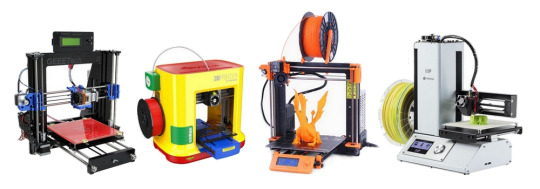
----------------------------------------------------------------------------------------------------
STARTT $99.99
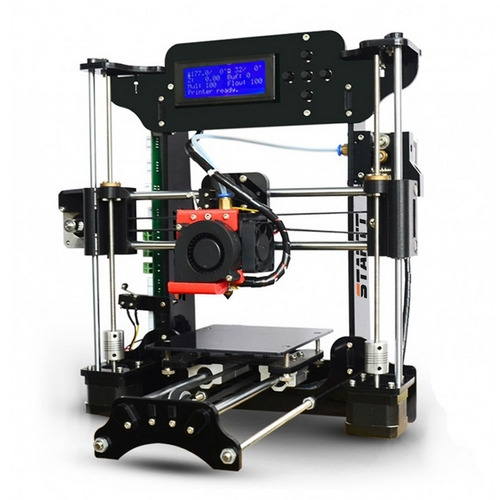
The STARTT is a great way to start(t) with 3D printing. It is supplied as a simple kit that can be assembled in around 5 hours, enabling you to understand how a 3D printer works. Despite this model being affordably priced, the printing quality is impressive. The STARTT is compatible with any open source slicer like Cura, and is loaded with pre-sliced 3D printable designs, compliments of MyMiniFactory.
You can purchase this model here.
Check out some of STARTT’s 3D-printable designs here!
Key Statistics:
DIY kit: Yes Type: FDM Weight: 4 kg Max. build volume: 120 mm x 140 mm x 130 mm Min. layer height: 100 microns Filament diameter: 1.75 mm Extruder: Single Heated bed: No Open source: Yes Wireless: No
----------------------------------------------------------------------------------------------------
101 Hero $79
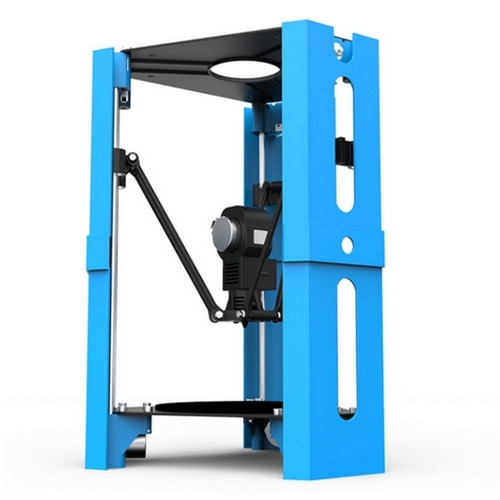
101HERO launched on Kickstarter with the objective of being the world's most affordable 3D printer - the campaign was a great success raising more than $1M. This printer will come in 2 editions the Customer Version will be a kid-friendly edition, which allows users to print designs via an SD card. The Designer & Developer version will be more advanced, with a USB connection and open-source software compatibility.
You can pre-order this printer here.
Try out some support free prints on this one to get started, grab them here.
Key Statistics:
DIY kit: 90% pre-assembled Type: FDM Weight: 1.86 kg Max. build volume: 150 mm diameter x 100 mm height Min. layer height: 50 microns Filament diameter: 1.75 mm Extruder: Single Heated bed: No Open source: Designer & developer version only Wireless: No
----------------------------------------------------------------------------------------------------
Tronxy X1 $187
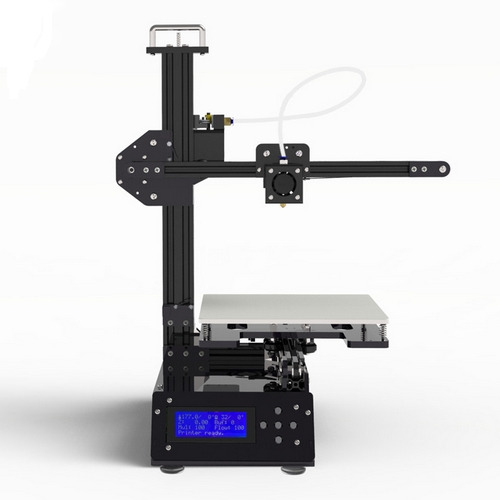
This Chinese aluminium DIY kit is one of the cheapest 3D printers on the market. Suitable for PLA and ABS, it’s a basic model, easy to assemble and it can be recommended to beginners.
You can purchase this 3D printer here.
Key Statistics:
DIY kit: Yes Type: FDM Weight: 3.5 kg Max. build volume: 150 mm x 150 mm x 150 mm Min. layer height: 100 microns Filament diameter: 1.75 mm Extruder: Single Heated bed: No Open source: No Wireless: No
----------------------------------------------------------------------------------------------------
Tronxy P802M $204
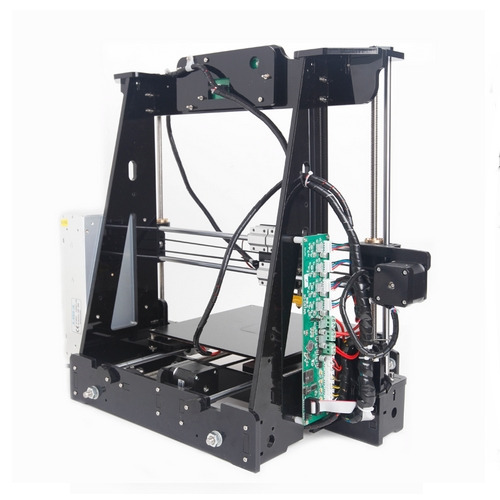
It makes use of Repetier-Host and Cura for slicing. The P802M is great value for its cost and is recommended for home use and to beginners.
You can purchase this model here.
Download free electronics 3D-printable designs here.
Key Statistics:
DIY kit: Yes Type: FDM Weight: 8 kg Max. build volume: 220 mm x 220 mm x 240 mm Min. layer height: 50 microns Filament diameter: 1.75 mm Extruder: Single Heated bed: Yes Open source: No Wireless: No
----------------------------------------------------------------------------------------------------
Anet A8 $170
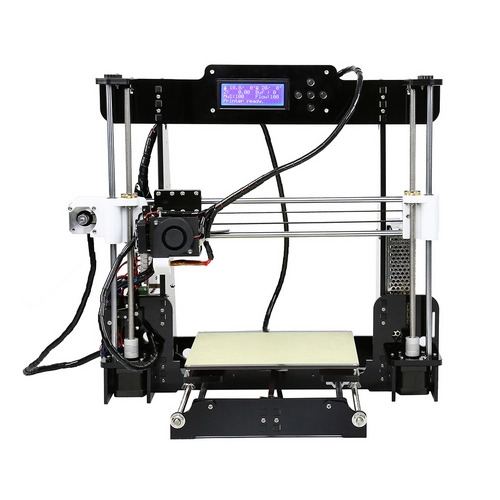
The A8 is the cheapest model from the Chinese brand Anet. Some parts of this DIY kit can be 3D printed and changed if needed. This model is very popular which means there is a great community on the web, and lots of customisation available to kick start your 3D experience. The A8's affordable price tag makes it a favourite among consumers, but that doesn't mean that this printer isn't a 3D printing powerhouse. It boasts a large print area and very capable NEMA17 motors to navigate the print-space. The A8 comes stock with a versatile extruder and heated bed, which makes it capable of printing a diverse selection of filaments.
You can buy this 3D printer here.
And for the DIY lovers, here you can download for free thousands of 3D-printable spare parts!
Key Statistics:
DIY kit: Yes Type: FDM Weight: 8.5 kg Max. build volume: 220 mm x 220 mm x 240 mm Min. layer height: 100 microns Filament diameter: 1.75 mm Extruder: Single Heated bed: Yes Open source: No Wireless: No
----------------------------------------------------------------------------------------------------
Anet A6 $198
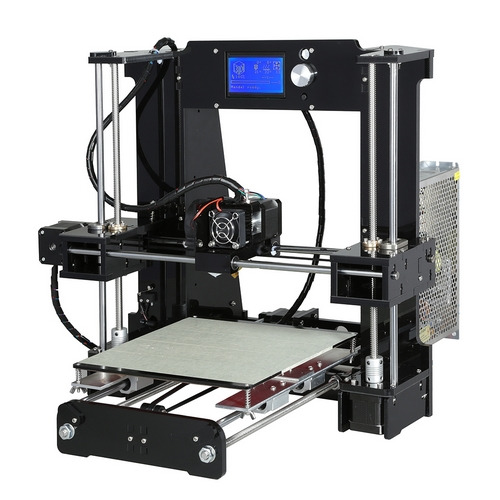
The A6 is a bit more expensive than the A2 and A8 but has a bigger build volume.This model is a 3D printer with acrylic frame and single extruder. To maintain the garage-built feel and the handmade charms, Anet A6 3D desktop printer is also a build-it-yourself kit.
You can purchase this model here.
The build volume will enable you to print objects such as these.
Key Statistics:
DIY kit: Yes Type: FDM Weight: 7.6 kg Max. build volume: 220 mm x 220 mm x 250 mm Min. layer height: 100 microns Filament diameter: 1.75 mm Extruder: Single Heated bed: Yes Open source: No Wireless: No
----------------------------------------------------------------------------------------------------
Anet A2 $203
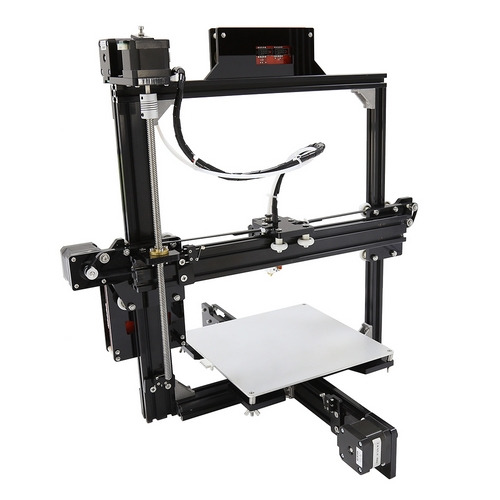
The A2 has a build volume a bit smaller than the A6 and A8, but also a smaller minimum layer height. This 3D printer adopts the high-end configuration with stable performance, and the compact body ensures portability. It is an unassembled DIY kit, which provides you with a step-by-step guide to build the 3D printer from scratch.
You can buy this model here.
Key Statistics:
DIY kit: Yes Type: FDM Weight: 4 kg Max. build volume: 220 mm x 220 mm x 220 mm Min. layer height: 50 microns Filament diameter: 1.75 mm Extruder: Single Heated bed: Yes Open source: No Wireless: No
----------------------------------------------------------------------------------------------------
Super Helper SH105 $149
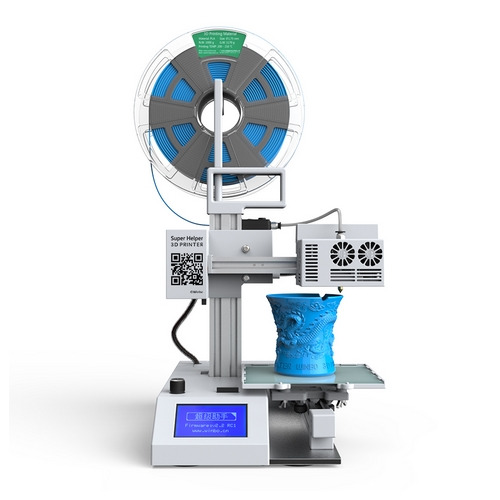
Launched by the Chinese brand Winbo, the SH105 is one of the cheapest 3D printers on the market. The SH105L is $50 more expensive than the SH105 and includes a laser head. Described as being suitable for a wide variety of applications including education, design, manufacturing, and general home and business use, the Super Helper looks to be easy to use, and its portability is a big plus.
You can purchase this 3D printer here,.
Judging by the photo this one is going to be great for planters - download some here.
Key Statistics:
DIY kit: No Type: FDM Weight: 3.6 kg Max. build volume: 105 mm x 105 mm x 155 mm Min. layer height: 40 microns Filament diameter: 1.75 mm Extruder: Single Heated bed: No Open source: No Wireless: No
----------------------------------------------------------------------------------------------------
Q3D OneUp 3D $199
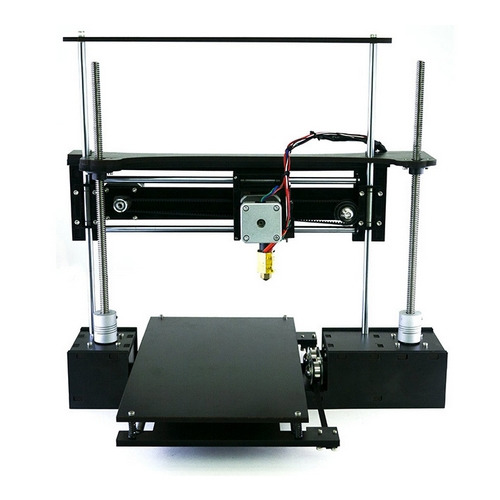
This self-assembled 3D printer is one of the cheapest on the market for the moment, and clearly a good and honest printer for its price. For beginners, buying and building a DIY kit like this one (2-8 hours to build) is recommended to understand the ins and outs and the ups and downs of a 3D printer. With over 7,000 units out in the wild, the OneUp is the standard for entry level 3D printer kits. This model sets itself apart from other 3D printers in its class by using the finest linear motion components, including chromed, induction hardened linear shafts, dual precision ACME screws (for the Z axis) and LM8LUU linear bearings for double the rigidity over the LM8UU bearings used in most printer kits. Each of the linear motion components is tied together with a CNC laser cut melamine frame (made in the USA) which provides not only rigidity but lightweight for high-speed printing. With improved print speeds up to 100mm/s due to the lighter weight extruder and hot end, print time is apparently cut almost in half.
You can purchase this model here.
And here are some free 3D-printable designs great for first-time printers!
Key Statistics:
DIY kit: Yes Type: FDM Weight: 4 kg Max. build volume: 100 mm x 100 mm x 125 mm Min. layer height: 50 microns Filament diameter: 1.75 mm Extruder: Single Heated bed: Optional Open source: No Wireless: No
----------------------------------------------------------------------------------------------------
Creality CR-7 $256
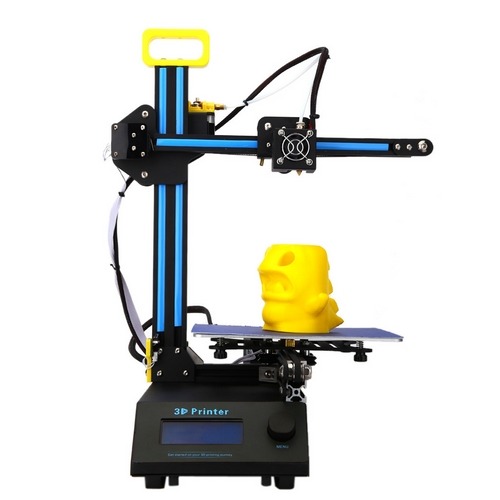
The Creality CR-7 is a good machine for 3D DIY enthusiasts, and suitable for a wide range of customers. This desktop 3D printer is easy to assemble, electric-proof, anti-scald and scratch resistant. With its Ilight weight, stability, and low noise, it will provide you with a good experience of 3D printing.
You can purchase this model here.
Key Statistics:
DIY kit: Yes Type: FDM Weight: 3.5 kg Max. build volume: 130 mm x 150 mm x 100 mm Min. layer height:100 microns Filament diameter: 1.75 mm Extruder: Single Heated bed: No Open source: No Wireless: No
----------------------------------------------------------------------------------------------------
Q3D TwoUp 3D $239
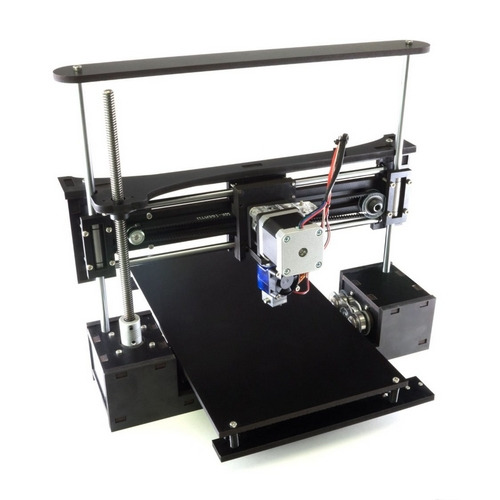
The TwoUp has the same specs than the OneUp except that the build volume is bigger: 175 L x 175 W x 125 H.
Buy it here.
Key Statistics:
DIY kit: Yes Type: FDM Weight: 4 kg Max. build volume: 175 mm x 175 mm x 125 mm Min. layer height: 50 microns Filament diameter: 1.75 mm Extruder: Single Heated bed: Optional Open source: No Wireless: No
----------------------------------------------------------------------------------------------------
Q3D ThreeUp 3D $279
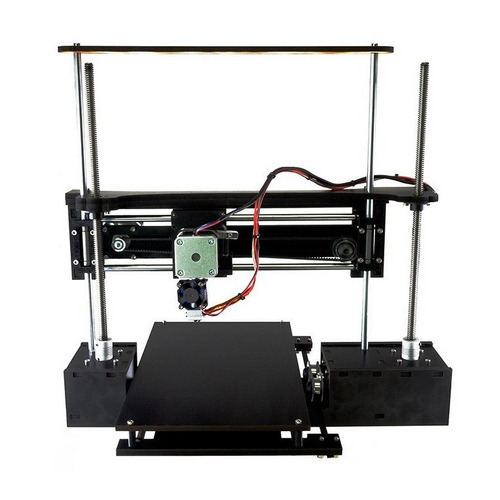
The ThreeUp has the same specs than the OneUp and the TwoUp except that the building volume is even is bigger: 175 L x 175 W x 210 H.
You can purchase it here.
Key Statistics:
DIY kit: Yes Type: FDM Weight: 5.9 kg Max. build volume: 175 mm x 175 mm x 210 mm Min. layer height: 50 microns Filament diameter: 1.75 mm Extruder: Single Heated bed: Optional Open source: No Wireless: No
----------------------------------------------------------------------------------------------------
Da Vinci Junior $189.99
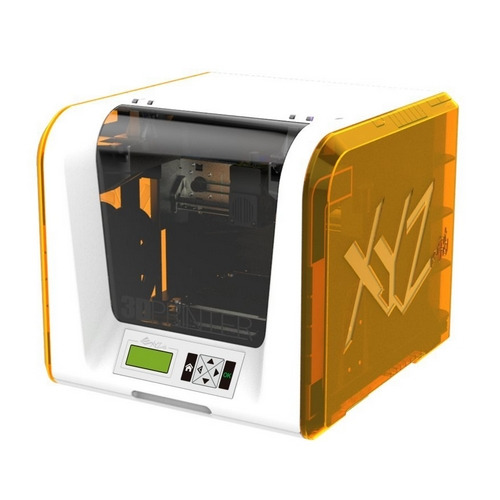
This 3D printer is the cheapest machine from XYZprinting, who also sell the Da Vinci miniMaker and the Da Vinci Mini. The Da Vinci Jr. has a robust build size of 5.9 x 5.9 x 5.9 inches and a resolution of 100 to 400 microns. Its design allows for the inclusion of an auto-feeding filament system, which takes the PLA filament to the extruder, and ensures that the filament is loaded properly and is ready to print. The Jr. 1.0 only prints in DEHP-free and Heavy metal-free PLA filament.
You can purchase this 3D printer here.
Key Statistics:
DIY kit: No Type: FDM Weight: 15 kg Max. build volume: 150 mm x 150 mm x150 mm Min. layer height: 100 microns Filament diameter: 1.75 mm Extruder: Single Heated bed: No Open source: Yes Wireless: Yes
----------------------------------------------------------------------------------------------------
Da Vinci miniMaker $249.99
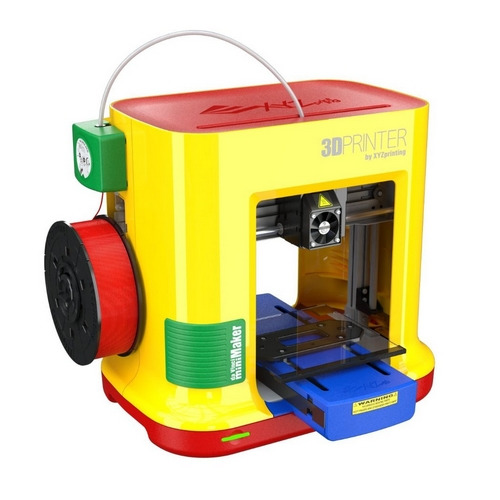
The Da Vinci miniMaker is a desktop 3D printer for beginners and children. Eco-friendly and easy to use, its lightweight and compact design fit easily in tight places. It has an auto-leveling bed and the auto-calibrating extruder module ensures the best possible prints. The miniMaker only prints in DEHP-free and Heavy metal-free PLA filament, ensuring that prints are safe for children and family.
You can purchase this model here.
The Da Vinci miniMaker will enable you to print very cool designs, such as toys and games downloadable here for free.
Key Statistics:
DIY kit: No Type: FDM Weight: 11.5 kg Max. build volume: 150 mm x 150 mm x150 mm Min. layer height: 100 microns Filament diameter: 1.75 mm Extruder: Single Heated bed: No Open source: Yes Wireless: No
----------------------------------------------------------------------------------------------------
Da Vinci Mini $288.79
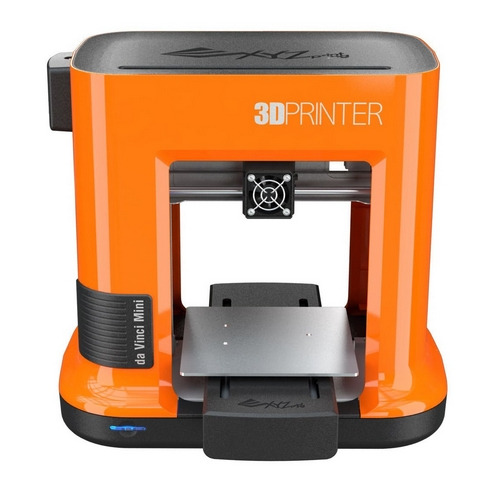
The Da Vinci Mini is a multifunctional 3D printer for beginners. This model is 30 percent smaller than da Vinci Jr. 1.0 and has a 5.9 inch x 5.9 inch x 5.9 inch aluminium print bed for larger and finer prints.
You can buy this model here.
Key Statistics:
DIY kit: No Type: FDM Weight: 10 kg Max. build volume: 150 mm x 150 mm x150 mm Min. layer height: 100 microns Filament diameter: 1.75 mm Extruder: Single Heated bed: No Open source: Yes Wireless: Yes
----------------------------------------------------------------------------------------------------
Monoprice Select Mini $199.99

The US technology company Monoprice imported the Malyan M200 from China, rebadged each unit to carry their logo and offered it for sale at the very affordable price of $199.99. Unlike most other low-cost 3D printers, this printer ships fully assembled and has already been calibrated at the factory. Sample PLA filament and a MicroSD card with preinstalled models are included so you can start printing right out of the box. Whilst there are a few defaults, the Select Mini is a good product for its price, and is a recommendable 3D printer for first-time users.
You can purchase this 3D printer here.
Key Statistics:
DIY kit: No Type: FDM Weight: 4.5 kg Max. build volume: 120 mm x 120 mm x120 mm Min. layer height: 100 microns Filament diameter: 1.75 mm Extruder: Single Heated bed: Yes Open source: No Wireless: Yes
----------------------------------------------------------------------------------------------------
TEVO Tarantula i3 $201

The Tarantula i3 is based on the Prusa i3, a proven design with tens of thousands users all around the world. This DIY kit features automatic bed levelling (optional) and bigger bed (optional). The auto-leveling version uses a proximity sensor to detect the aluminium print bed where the normal version of the printer uses a microswitch to detect the end of travel for the Z-Axis movement (vertical limits). It is very good value for the cost and will enable you to understand how 3D printing works.
You can buy this model here.
Key Statistics:
DIY kit: Yes Type: FDM Weight: 7.5 kg Max. build volume: 200 mm x 200 mm x 200 mm (or 200mm x 280mm x 200mm optional) Min. layer height: 50 microns Filament diameter: 1.75 mm Extruder: Dual Heated bed: Yes Open source: Yes Wireless: No
----------------------------------------------------------------------------------------------------
HE3D EI3 $210

This DIY 3D printer is the cheapest one from the Chinese brand HE3D. This kit has an upgraded frame using 2020 and 2040 extruded aluminium beams and 7mm reinforced acrylic supports and an upgraded ATmega2560 control board with support for up to two print heads and an intuitive LCD user interface panel. The heated 8x8x8 inch print area, 12 micron X/Y accuracy and 50-micron layer accuracy, and auto z-calibration ensure each print will achieve stunning detail and quality. The extruder’s wide temperature ranges support a variety of printer filament material including most varieties of PLA, ABS, PETG, Wood, and PVA material.
You can purchase this model here.
Key Statistics:
DIY kit: Yes Type: FDM Weight: 8.5 kg Max. build volume: 200 mm x 200 mm x 200 mm Min. layer height: 50 microns Filament diameter: 1.75 mm Extruder: Single or dual/triple optional Heated bed: Yes Open source: No Wireless: No
----------------------------------------------------------------------------------------------------
HE3D K200 $239
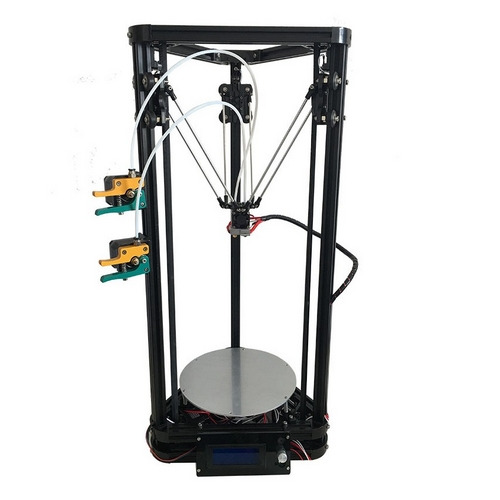
This DIY 3D printer, bigger than the HE3D EI3, will enable you to print objects in very good quality. The K200 breaks from the traditional limitations of Cartesian printers and offers precision and speed with a build volume over 1000 inches (11 in. diameter, 11 in. height)! The kit is built with the new enthusiast and experts in mind. With high quality 2020 aluminium extruded beams and acrylic forms the construction is simple, yet very robust. The E3D double extruder opens the possibilities to multiple print colours without having to pause, clean, and reposition. Both extruders support temperature range up to 260C to support almost all filament material including PLA, ABS, TPU, WOOD, PVA, Nylon, PVA, PP and most of their variants. The upgraded LCD interface and ATmega2560 control board with RAMPS PLUS2 and 80 step precision motors give this printer an ultra-high print quality down to 12 micron X, Y and 50-micron layer accuracy.
You can buy this 3D printer here.
Printing tall objects like these won’t be an issue anymore!
Key Statistics:
DIY kit: Yes Type: FDM Weight: 9 kg Max. build volume: 200 mm diameter x 300 mm height Min. layer height: 50 microns Filament diameter: 1.75 mm Extruder: Single or dual optional Heated bed: Optional Open source: No Wireless: No
----------------------------------------------------------------------------------------------------
FLSUN Prusa i3 $219

This Chinese model is a good and affordable 3D printer for beginners. The metal structure is stable and provides a good printing accuracy. It has a high precision Y-axis position plate and guarantees Y-axis positioning accuracy. The printer controller is integrated motherboard, easy to connect and support DIY spread.
You can purchase this printer here.
If you feel like this will be easy to build, try printing these objects with it!
Key Statistics:
DIY kit: Yes Type: FDM Weight: 10 kg Max. build volume: 200 mm x 200 mm x 200 mm Min. layer height:100 microns Filament diameter: 1.75 mm Extruder: Single Heated bed: Yes Open source: Yes Wireless: No
----------------------------------------------------------------------------------------------------
Heacent i3 $145

This Chinese DIY kit is an affordable 3D printer that will give you a good step-by-step learning experience. Suitable for a wide range of customers, the quality of the product is apparently very good for its price.
Purchase this 3D printer here.
Key Statistics:
DIY kit: Yes Type: FDM Weight: 6.6 kg Max. build volume: 200 mm x 200 mm x 180 mm Min. layer height: 100 microns Filament diameter: 1.75 mm Extruder: Single Heated bed: Yes Open source: No Wireless: No
----------------------------------------------------------------------------------------------------
Geeetech Prusa I3 pro B $248.54
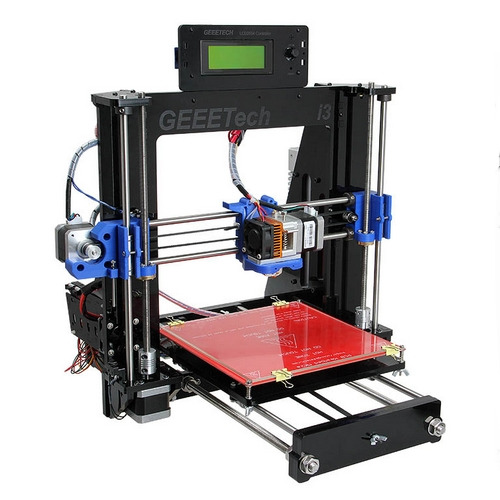
The Prusa I3 pro B is the cheapest 3D printer from Geeetech. It is based on Geeetech I3 pro, except its simple assembly, easy debugging and more stable performance, compared with the I3 pro, I3 pro B features a newly added potential for 3D printing—support 5 types of filament: ABS, PLA, Wood-Polymer, Nylon and flexible PLA., create flexible hinges, joints, shaped parts; enable you to get the most out of your 3D Printer.
You can buy this model here.
Key Statistics:
DIY kit: Yes Type: FDM Weight: 8.5 kg Max. build volume: 200 mm x 200 mm x 180 mm Min. layer height: 100 microns Filament diameter: 1.75 mm, 3.0 mm Extruder: Single Heated bed: Yes Open source: No Wireless: No
----------------------------------------------------------------------------------------------------
Geeetech Prusa I3 pro C $299

A little bit more expensive, the Prusa I3 pro C has the same specs than the pro B except that it has 2 extruders. You can print a single two-color object, or you can print two objects in one print job, each made from a different colour. You can also print one single-color object, as with other single-extruder 3D printers. Or you can use one extruder for infill or support. The 2 extruder motors push filament through 2 head separately, so mixing colours printing is not applicable for the moment. Geeetech I3 pro C support 5 types of filament: ABS, PLA, Wood-Polymer, Nylon and flexible PLA.
Buy this 3D printer here.
Key Statistics:
DIY kit: Yes Type: FDM Weight: 9 kg Max. build volume: 200 mm x 200 mm x 180 mm Min. layer height: 100 microns Filament diameter: 1.75 mm, 3.0 mm Extruder: Dual Heated bed: Yes Open source: No Wireless: No
----------------------------------------------------------------------------------------------------
Cetus 3D $299
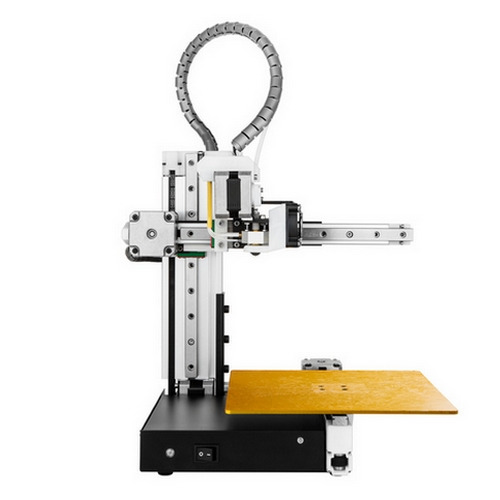
After a successful Kickstarter campaign, Cetus 3D launched a very basic and solid printer. Quiet, small and cheap, this model can be recommended for every beginner. At 0.25, the build volume to machine volume ratio is excellent, and the light weight will enable you to take it with you everywhere. The Cetus 3D printer features cloud-based support for remote printing and notifications as well as dedicated 3D printing software.
You can purchase the Cetus 3D here.
Key Statistics:
DIY kit: No Type: FDM Weight: 3.2 kg Max. build volume: 180 mm x 180 mm x 180 mm Min. layer height: 50 microns Filament diameter: 1.75 mm Extruder: Single Heated bed: No Open source: Yes Wireless: Yes
----------------------------------------------------------------------------------------------------
M3D Micro $299
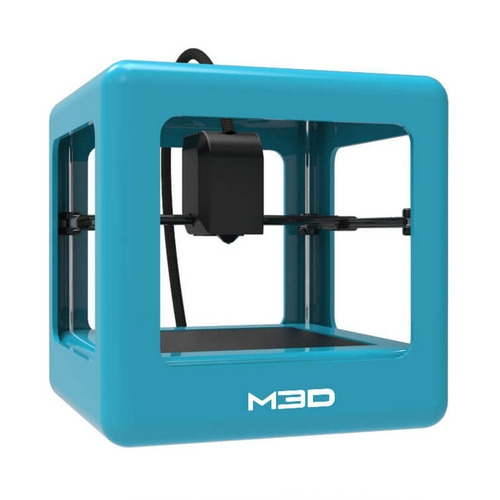
Rated best 3D printer in class by 3D Forged & Tom's Guide, this model is the cheapest 3D printer from M3D. The Micro is the world’s first truly consumer 3D printer and is powered by "Micro Motion Technology," a series of next generation innovations, creating precision at a fraction of the cost of other 3D Printers. Sporting a compact design, cool colour choices, user-friendly software, and replaceable print beds and nozzles, it’s a great 3D printer for beginners and experts alike. The Micro comes with M3D Software for Windows operating systems. The software has an easy-to-use interface and is fully touch screen capable. The M3D Software allows you to organise the 3D models you've downloaded into an easy to view library.
You can buy this 3D printer here.
Key Statistics:
DIY kit: No Type: FDM Weight: 1 kg Max. build volume: Base:109 mm x 113 mm x 74 mm, and above the 74 mm: 91 mm x 84 mm x 42 mm Min. layer height: 50 microns Filament diameter: 1.75 mm Extruder: Single Heated bed: No Open source: Yes Wireless: No
----------------------------------------------------------------------------------------------------
Snapmaker $299
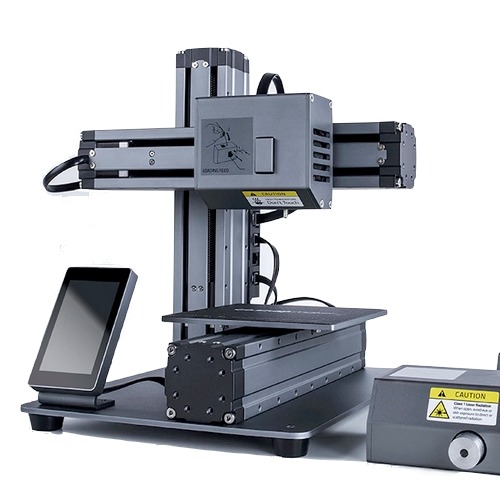
A Kickstarter campaign has been launched to raise funds for this affordable all-metal and all-in-one 3d printer. It is easy-to-use for beginners, expandable for makers, and will enable you to do 3D printing, laser engraving and CNC carving. Designed for quick assembly, strong expandability and real affordability. Snapmaker has an innovative modular design, which enables a flat-packed and low-cost shipping, quick assembly and personalised modification. With the intuitive-to-use 3.2-inch colour touchscreen, you can conveniently control all print settings.
You can pre-order the Snapmaker here.
Key Statistics:
DIY kit: Yes Type: FDM Weight: 4.5 kg Max. build volume: 125 mm x 125 mm x 125 mm Min. layer height: 50 microns Filament diameter: 1.75 mm Extruder: Single Heated bed: Yes Open source: Yes Wireless: No
----------------------------------------------------------------------------------------------------
Bonus: other notable entry level 3D printers
----------------------------------------------------------------------------------------------------
Dagoma DiscoEasy200 $317
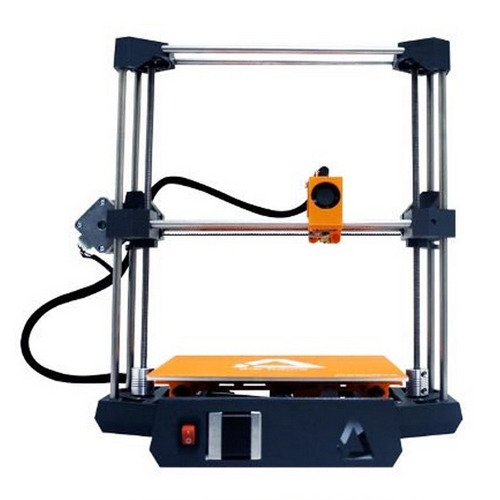
The french brand Dagoma improved its model Discovery, who became DiscoEasy. This model is based on an open source design, which makes it easy to modify. Its 3D files are accessible for free online. The Dagoma DiscoEasy200 does not provide natively a printing bed but can get one as an option. Compared to its predecessor, the DiscoEasy200 offers a new electronic card, an additional fan on the extruder and a SD card port instead of a mini SD. This 3D printer is intuitive and recommendable to the beginners.
You can purchase this model here.
And here are some cool objects designed by Dagoma that you can print with the DiscoEasy200!
Key Statistics:
DIY kit: No Type: FDM Weight: 5 kg Max. build volume: 200 mm x 200 mm x 200 mm Min. layer height: 100 microns Filament diameter: 1.75 mm Extruder: Single Heated bed: No Open source: Yes Wireless: No
----------------------------------------------------------------------------------------------------
Kodama Trinus $379
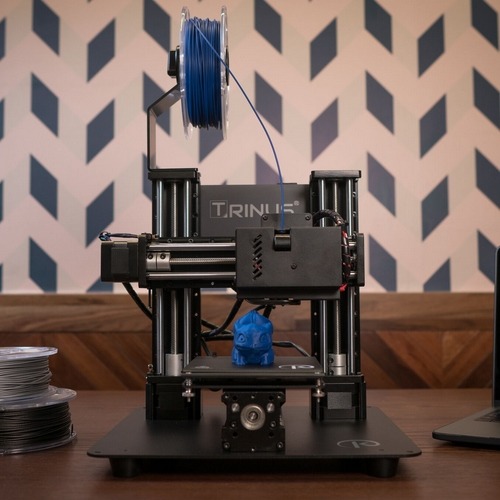
Kodama launched a Kickstarter campaign to market the new affordable 2-in-1 Trinus 3D printer. Trinus is a professional-grade desktop 3D printer that can easily be converted into a laser engraver. The kit contains only 11 parts and can be assembled easily. You can also equip the Trinus with a heated bed and a safety enclosure. This all-metal 3D printer extrudes PLA, ABS, PC, Flex, wood and most other materials available on the market. This model is very quiet and print objects in good quality.
You can pre-order the Trinus here.
Key Statistics:
DIY kit: Yes Type: FDM Weight: 9.8 kg Max. build volume: 120 mm x 125 mm x 125 mm Min. layer height:50 microns Filament diameter: 1.75 mm Extruder: Single Heated bed: Optional Open source: No Wireless: No
----------------------------------------------------------------------------------------------------
Honorable Mentions:
New Matter MOD-t $399

New Matter launched the MOD-t after realising an Ingiegogo campaign. This model is easy to use and has a good printing quality. The MOD-t’s beautiful clear cover and patented design makes it one of the quietest desktop 3D printers available, so it can easily live in a classroom or living room without causing disruption. The MOD-t is dependable with WiFi connectivity, a simple set-up process, and intuitive controls. If any questions arise, the New Matter Customer Support team is available for users through email, phone, and chat.The Wall Street Journal recommends the MOD-t for anybody’s “first foray into 3-D.”
You can purchase this 3D printer here.
Key Statistics:
DIY kit: No Type: FDM Weight: 5 kg Max. build volume: 150 mm x 100 mm x 125 mm Min. layer height:100 microns Filament diameter: 1.75 mm Extruder: Single Heated bed: No Open source: Yes Wireless: No
----------------------------------------------------------------------------------------------------
Robo 3D C2 $699.99
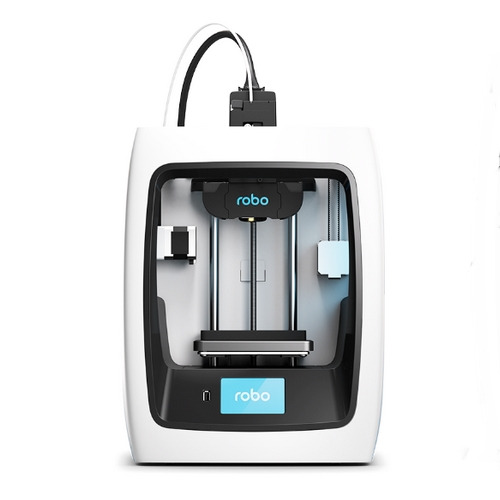
The Robo 3D C2 is a small desktop 3D printer launched after a Kickstarter campaign. This model is more expensive but can print with great quality and efficiency. The Robo 3D C2 is a small desktop 3D printer. It has a nice and simple design, with an easy to access build platform. It is compatible with the Robo app and also adds a Wifi connectivity for a smooth user experience. The Robo 3D C2 print bed is not heated so it is not capable of 3D printing ABS.
You can buy this model here.
Key Statistics:
DIY kit: No Type: FDM Weight: 9.4 kg Max. build volume: 127 mm x 127 mm x 152.4 mm Min. layer height: 20 microns Filament diameter: 1.75 mm Extruder: Single Heated bed: No Open source: Yes Wireless: Yes
----------------------------------------------------------------------------------------------------
Prusa i3 MK2 kit $786
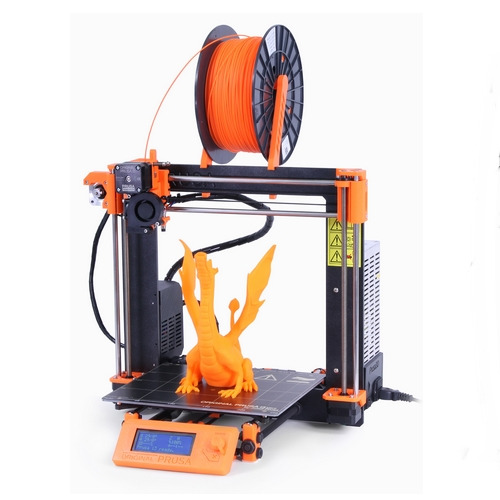
The very popular Prusa i3 from Josef Prusa is considered as the 3D printer with the best quality for its cost. It comes with a bunch of clever features and is upgradable. With tens of thousands users all around the planet, this popular model has a made a big impression on the 3D printing community since it was launched. All parts of this 3D printer are Open Source and are part of the RepRap project.
You can buy this 3D printer here,
Check out the Prusa MyMiniFactory profile here if you need spare parts!
Key Statistics:
DIY kit: Yes Type: FDM Weight: 6.5 kg Max. build volume: 250 mm x 210 mm x 200 mm Min. layer height: 50 microns Filament diameter: 1.75 mm Extruder: Single Heated bed: Yes Open source: Yes Wireless: No
1 note
·
View note
Text
Upgrade Your Kitchen Gear with the Ankarsrum Assistent Original Stand Mixer
The Ankarsrum Assistent Original is a beautiful machine that’s ready to help complete many kitchen tasks. Best known as a high-end mixer that’s perfect for mixing and kneading bread dough, it can also mix cake batter, churn butter, mix cookie dough, whip cream, and much more all without any additional accessories. This powerful mixer with an excellent warranty may be the last one you ever need to buy.
Here is everything that comes in the box.
I was first introduced to the Ankarsrum Assistent (yes “Assistent” is spelled correctly, it’s Swedish) while researching my review of the Challenger Bread Pan. Challenger Breadware only carries the best equipment for home bread baking, so I was instantly intrigued. The Ankarsrum, or “Ank” as it’s affectionately referred to by its users, is made out of chrome and steel, and it is built to last. The 600-watt motor is strong enough to mix up to 5kg (or 11 pounds!) of dough in the 7-liter stainless steel bowl.
Ank with the roller and scraper
The Ank with its plastic bowl and double beater.
The Ank comes with a 7L steel bowl as well as a 3.5L clear plastic bowl. The large stainless bowl is to be used for bread doughs while the smaller plastic bowl is to be used for cake batter, cookie dough, whisking meringue, making icing, etc. With the stainless steel bowl, you can use the included dough hook, roller, scraper, and cover. With the plastic bowl, you will use the included double beaters. You get two sets of whisks, one set of balloon whisks, and one set of pastry whisks.
Shiny control knobs
The back of the unit.
The Ankarsrum Assistent is uniquely engineered so that the motor is located at the bottom of the unit, and the bowl itself spins. This design provides for a completely open top, which makes it easy to add flour, water, etc. as the mixer is spinning. The open top also allows you to see and feel the dough much easier than competitors. There is a movable steel arm that spans over the bowl, which holds the roller, while the scraper attaches to the side of the bowl and remains stationary while the bowl spins. This design simultaneously rolls and kneads the dough, making it similar to kneading with human hands. You also use a dough hook instead of the roller arm, which leads to a little more tearing while kneading, but many people use it with great success.
Kneading my first dough, NY Style pizza dough.
The same pizza dough
NY Style pizza dough rolled into balls and ready to ferment in the fridge for a few days.
The setup with the plastic bowl is pretty nifty. The bowl has a hole in the middle that allows a central shaft to connect to the motor assembly. The double beater assembly then connects to the top of the shaft and spins using the internal gears. It’s a cool setup that works well but requires a lot of small parts and pieces to use.
The Ank is controlled using two knobs. The left knob is the on/off/timer. You turn the knob one click to turn it on, and if you keep going past “on,” you can select a timer setting where the Ank will turn off automatically after up to 12 minutes. The speed is controlled using the right knob, and it’s completely adjustable, unlike most mixers that have specific speed settings. You can take the Ank from 45 to 130 rpm and adjust it anywhere in between. Surprisingly, it’s a fairly quiet motor, which is nice considering I share the house with my wife and kids, and they’d get annoyed with a loud motor.
A look at the recipes included in the hardcover recipe book.
Ankarsrum kindly provides a nicely designed, hardcover recipe book with each Assistent. Recipes include everything from hamburger buns, focaccia, and standard bread loaves, to desserts, cookies, pasta, smoothies, milkshakes, and more. The recipe book is surprisingly well-designed and photographed, and the recipes are specifically formulated for use in the Ank.
One more advantage that Ankarsrum carries over its competitors is it’s a serious warranty, boasting a SEVEN-year warranty on the motor base and a one year warranty on accessories. The warranty only applies to the original purchaser, however, so be forewarned in the secondary market. This is a massive advantage over comparable units that carry a mere two-year warranty.
A look at the crumb of my NY Style pizza dough.
My pizza, because who doesn’t like pizza?
So let’s talk about my experience testing the Ankarsrum Assistent. Keep in mind that I’ve been using a KitchenAid Artisan series, tilt-head mixer for years, so that’s my basis for comparison. While I feel like a KitchenAid Pro Series bowl-lift stand mixer is a more apt comparison spec-wise, I haven’t used one myself. There’s certainly a learning curve when going from a KA mixer to the Ankarsrum Assistent, and it took some time for me to feel confident, but the huge bowl and powerful motor were appreciated early and often.
Homemade sourdough bagels, mixed and kneaded in the Ank.
They were awesome. Come to think of it; I think I still have some in the freezer!
With the Ank, you’re supposed to put in all of the liquid ingredients first, then add your flour slowly until your dough comes together. I’ve watched a lot of videos recommending that the Ank allows you to use slightly less flour than a recipe calls for; however, I’m a bit anal when it comes to recipes, especially when baking, so I typically used the recommended amount of flour. I used the roller the most when mixing my bread dough since that’s supposed to be the closest way to mimic hand kneading. When mixing the water, oil, yeast, etc., I pushed the arm toward the center and back to help the ingredients mingle, then I added the flour slowly until it all combined into a nice dough. The experience of being able to dump all the ingredients in while it was spinning, without having to lower the bowl, tilt the head back, or try to sneak in between the head and the bowl, was fantastic.
Once the dough was formed, I reduced the speed to allow it to knead gently. The dough rolls around inside the bowl, getting lightly squeezed between the roller and the side of the bowl, then kicked back by the scraper. It’s an efficient way to keep the dough moving while gently kneading it. The perimeter of the roller itself is scalloped, mimicking the shape of human fingers. As mentioned, there’s a learning curve when using the Ank, and I wasn’t always sure that my dough was properly kneaded, however, my final products always came out great.
M&M cookie dough in progress
We made a few different types of bread in the stainless bowl, including pizza dough (my favorite) a few times, challah, and sourdough bagels. The process, while different than what I’m used to, was reasonably easy to adapt to. I found that the combination of the roller and scraper did seem like human hands were kneading the dough, and it definitely felt more gentle than I’m used to with a KA dough hook. The dough was adequately kneaded to develop the gluten in the bread, though it took slightly longer than I expected, approximately 10 minutes or so. Each turned out as expected: the challah was light and soft, the bagels were chewy on the inside and crisp on the outside, while the pizza dough had great oven spring and was crisp on the outside and soft on the inside.
Delicious, who doesn’t want some M&M cookies?
We also made M&M cookies using the plastic bowl and double beaters. We used the balloon (cookie) whisks to cream the room temperature butter before adding the sugar. The cookies came out great, as they were well mixed using the plastic bowl and double beaters. It was actually mesmerizing watching the double beaters work. Butter is a point worth mentioning. The Ankarsrum doesn’t have a solid “paddle” beater like KitchenAid mixers do, so it doesn’t have the ability to cream butter from the fridge. Ankarsrum makes it very clear that all butter must be room temperature before creaming. This may be an inconvenience to some, as it requires some forethought, but it’s not the end of the world.
After a few weeks of testing and many uses, I can confidently say that the Ankarsrum Assistent Original is an excellent mixer for those home bakers who are looking to level-up their kitchen equipment. The 7L bowl and 600W motor make it especially great if you’re going to be making a lot of dough at one time. There’s absolutely a learning curve, so you’ll want to go into your purchase expecting some time getting used to your device, but once you dedicate yourself to it, you’ll be making great food for years and years to come. The Ank is built like a tank, and it has the 7-year warranty to back it up. I’ve seen posts on the Ankarsrum Facebook group from people showing off their 20+-year-old mixers (previously called Electrolux Assistent, DLX, Verona Magic Mill).
Challah dough about to be kneaded by the dough hook; please excuse the messy counter.
Challah!
The Ankarsrum Assistent is beautifully designed, from both an engineering and aesthetic perspective. It’s available in 12 colors, enough to coordinate with any kitchen while it’s stainless steel bowl and curved lines would look good sitting on your counter, assuming you have the counter space. It has a removable power cord, so you can store it away easier, as well as a bowl cover that doubles as an accessory bowl while the Assistent is in use. They thought of everything.
Ankarsrum also has several accessories available to extend the uses for your Assistent. These nifty accessories include a spaghetti roller/cutter, lasagna sheet roller, grain/spice/coffee mill, slicer/shredder, meat grinder, juicer, and even a blender. There so many accessories I’m not going to name them all here. You can check out the full list online.
As I said, if you’re looking for an upgrade to your kitchen gear, check out the Ankarsrum Assistent Original, expect a learning curve, but your patience will be rewarded with delicious baked goods for years to come. Stay tuned for an update later this summer, where I’ll be checking out some of Ankarsrum’s most popular accessories as well as a review video, showing a lot of footage from my testing.
The Ankarsrum Assistent Original Stand Mixer sells for $699, and you can purchase it directly from the manufacturer.
Source: Manufacturer supplied review sample
What I Like: Ingeniously engineered; Strong motor; Large bowl; Kneads similar to human hands; Super-versatile, especially when taking accessories into account; Comes in a ton of different colors; Outstanding warranty protection; Timeless retro design
What Needs Improvement: There’s a learning curve; It’s a bit large, so it may be hard to find storage for it in a small kitchen
from Joseph Rushing https://geardiary.com/2020/08/04/upgrade-your-kitchen-gear-with-the-ankarsrum-assistent-original-stand-mixer/
0 notes